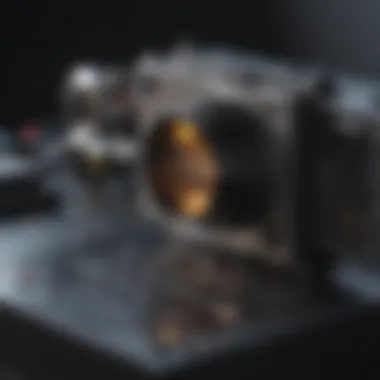Laser Light Measurement Devices: Principles and Applications


Overview of Topic
Laser light measurement devices have gained widespread recognition in various fields, particularly in engineering, construction, and scientific research. These instruments measure the distance or characteristics of objects through the use of laser light, allowing for high precision and accuracy in numerous applications. In essence, they utilize focused beams of light to gather data, which can then be analyzed and interpreted. Understanding how these devices work and their specific applications is crucial for anyone interested in the home improvement industry.
The importance of laser light measurement lies in their efficiency and reliability. Traditional measuring tools often fall short in accuracy, leading to potential errors in projects that require exact specifications. Conversely, laser measurement devices provide rapid measurements with minimal margin for error, making them indispensable in tasks ranging from home renovations to large-scale construction projects.
Common Challenges and Solutions
Homeowners often encounter various challenges when attempting to use laser light measurement devices. One common issue is misalignment. If the laser is not aligned correctly with the target surface, the measurement can be inaccurate.
Solutions:
- Proper Training: Ensuring that users are trained in the correct setup of the device can mitigate alignment issues. Taking time to read the user manual and understand the device's features is essential.
- Using Tripods: Employing stability tools, such as tripods, can help maintain alignment and prevent movement during measurements.
Another common problem is battery capacity. Many laser devices run on batteries, and a dead battery can lead to delays in project completion.
Solutions:
- Regular Maintenance: Checking battery levels before starting a project can lead to smoother operation. Keeping spare batteries handy is advisable.
- Upgrading to Rechargeable Batteries: Opting for devices with rechargeable batteries can be more efficient and environmentally friendly.
Product Recommendations
When looking for laser light measurement devices, several products stand out in the market. Some notable choices are:
- Bosch GLM 50 C: This model is known for its Bluetooth connectivity, allowing for easy data transfer to smartphones. Its range is impressive, offering measurements up to 165 feet.
- DeWalt DW099S: This robust device is built for rugged job sites, featuring laser technology that can measure both inside and outside.
- Benefits: User-friendly interface and clear display.
- Features: Integrated inclinometer for additional functionality.
- Benefits: High durability and shock resistance.
- Features: A bright laser for visibility in bright environments.
Understanding these specific products helps homeowners make informed decisions when selecting the best device for their needs.
Step-by-Step Guides
Implementing laser measurement can significantly enhance home improvement projects. Here’s a simple guide to using a laser light measurement device.
- Set Up the Device: Place the device on a stable surface or use a tripod. Ensure it is level for accurate measurements.
- Select the Measurement Mode: Depending on your needs, choose the appropriate mode, such as single measurement, continuous measurement, or area calculation.
- Aim the Laser: Point the laser at the target surface. Make sure it is aligned with the measuring spot accurately.
- Take the Measurement: Press the measurement button to capture the data. Wait for the device to process and display the result.
- Record the Measurement: Document the results in your planning notes or work schedule for future reference.
Implementing laser measurements does not have to be daunting. Proper setup and understanding the device's functions can lead to impressive improvements in efficiency and accuracy in your projects.
Prelude to Laser Light Measurement Devices
Laser light measurement devices have become essential in various fields. They offer precision and speed in measurement that traditional tools often cannot match. With their increasing use in construction, manufacturing, and scientific research, understanding these devices is critical.
These devices primarily utilize laser technology to measure distance, angles, and areas. The benefits include not only enhanced accuracy but also reduced time in taking measurements. These advantages hold significant value for professionals and homeowners alike, who seek efficiency in daily tasks or large projects.
When considering laser measurement devices, it is important to take into account the specific needs of each application. For example, a laser distance meter is perfect for quick distance checks, while a laser scanner may be more suited for detailed surveying. Understanding the differences and applications can greatly aid in making the right choice.
Adopting laser technology has implications for workflows and project outcomes, making it a crucial topic in today’s technology-driven environment.
"Laser measurement tools are not just about accuracy; they redefine how measurements are viewed and executed."
In the following sections, we will delve deeper into the definitions, principles, and historical background related to these devices, emphasizing the comprehensive scope of laser technology in modern practices.
Definition and Overview
Laser light measurement devices are instruments that use lasers to capture measurements with high accuracy. They work by emitting a laser beam that reflects off a target, returning to the device. The time it takes for the laser to return is used to calculate distance or other figures required. This method provides precise results over considerable distances, an attribute that is invaluable in many settings.
These devices can be simple handheld tools or complex systems integrated with software for data analysis. They play a pivotal role in making various tasks simpler and less labor-intensive.
Laser measuring devices can be broadly categorized based on their functionalities:
- Laser Distance Meters: Used for measuring distances in construction and renovation projects.
- Laser Scanners: Employed for creating detailed three-dimensional maps and models.
- Laser Interferometers: Used in scientific research for measuring minute displacements.
Historical Background
The development of laser measurement technology dates back to the 1960s, coinciding with the advent of laser technology itself. The first practical applications of lasers were discovered shortly after their invention by Theodore Maiman in 1960. Initially, these devices were bulky and expensive, limiting their use mainly to research laboratories.
Over the years, advancements in technology have led to miniaturization, reducing costs and expanding applications. By the late 20th century, laser measuring devices became more accessible to industries like construction and manufacturing. Today, laser measurement tools are common, providing benefits in various fields and enhancing product quality and project efficiency.
Understanding the historical context of these technologies helps comprehend their evolution and significance in a modern context, offering insight into future developments.
Principles of Operation
The principles of operation for laser light measurement devices form the backbone of their functionality. Understanding these principles is essential, as it provides insights into how these devices work, and the various factors that contribute to their effectiveness. These principles not only enhance the knowledge of the devices but also inform users about their practical applications.
Basic Physics of Laser Light
Laser light is distinct from ordinary light in several critical ways. To begin with, lasers generate light that is highly coherent. This means the light waves are uniform in phase, frequency, and direction. Such characteristics allow for precise measurements, making lasers especially useful in applications requiring high accuracy. The monochromatic nature of laser light, as it consists of a single wavelength, further enhances its measurement capabilities.
Moreover, lasers can produce a significant intensity of light. This intensity enables the effective reflection of emitted light off surfaces for distance measurement. The physics also include the properties of light interacting with surfaces, such as reflection, refraction, and scattering. These properties are important as they affect how measurements are interpreted.
How Measurement is Achieved
Measurement with laser devices is primarily achieved through a method known as time-of-flight measurement. In this process, a laser beam is directed at a target. Once the beam strikes the target, it reflects back to the measurement device. The time taken for this round trip is recorded and is utilized to calculate the distance. The formula used typically is:
This calculation is both straightforward and efficient.
Additionally, some devices employ triangulation methods for measurement. These involve using angles and distances to ascertain the location or dimensions of an object. By measuring the angle between the laser beam and a known point, the device can calculate dimensions with high precision. This method is particularly popular in areas that require intricate geometry, such as architecture and construction.
To summarize, understanding the basic physics of laser light and how measurements are realized through these principles is vital for users of laser measurement devices. These concepts grant users confidence in the reliability and accuracy of their measurements, vital qualities needed in environments ranging from construction to scientific research.
Types of Laser Measurement Devices
Understanding the various types of laser measurement devices is crucial to comprehending their applications and benefits. Each device serves specific needs, making it essential to choose the right one for your purpose. Laser measurement tools are based on the same fundamental concepts of light and distance. However, they differ in their functionality, technology, and the precision they offer.
This section looks into three primary types of laser measurement devices—Laser Distance Meters, Laser Scanners, and Laser Interferometers. Each type is uniquely designed to measure distances, create 3D representations, or evaluate minute changes, making them invaluable tools across many industries.
Laser Distance Meters


Laser distance meters are among the most popular laser measurement tools available. They measure distances by emitting a laser beam towards a target and calculating the time it takes for the reflection to return. This technology allows for precise distance calculations, often within a millimeter accuracy.
They are convenient for various applications, especially in construction and interior design. Homeowners can use these devices to determine wall lengths, measure furniture spaces, or assess areas for renovations. Their handheld nature makes them easy to use.
Key Benefits:
- High precision and accuracy
- Rapid measurements, saving time compared to traditional methods
- Compact and portable, ideal for residential use
In selecting a laser distance meter, consider factors like measuring range, battery life, and any additional features such as area calculation or volume measurement.
Laser Scanners
Laser scanners are more complex devices that create 3D representations of environments. They use a rotating beam to capture a multitude of points in space, generating detailed surface models. This functionality is especially beneficial in architecture, surveying, and mapping.
For homeowners, laser scanners provide an opportunity to visualize large spaces or even entire buildings. They can help plan renovations or additions by offering precise layouts. Additionally, these tools often integrate with software that aids in visualization and analysis.
Considerations:
- Requires more investment and expertise compared to laser distance meters
- Ideal for larger projects or those requiring high detail
- Useful for documenting changes in structure or design over time
Laser Interferometers
Laser interferometers are specialized devices designed for measuring extremely small distances or changes. They do so by using the interference of light waves. These are typically used in lab environments or high-end manufacturing processes.
Their ability to detect minute shifts makes them vital in scientific research and advanced applications like semiconductor manufacturing. For typical homeowners, these tools might be less relevant. However, they underscore the range and capabilities of laser technology.
Usage:
- Precision measurements in scientific studies
- Calibration of sensitive equipment
- Quality control in manufacturing environments
Key Components
Understanding the key components of laser light measurement devices is vital to grasp their functionality and effectiveness. These components work together seamlessly to convert laser light into usable data. They reflect the technology's precision, reliability, and potential for various applications. The three primary components include the laser source, receiving system, and processing unit. Each plays a crucial role in ensuring accurate measurements.
Laser Source
The laser source is the heart of any laser measurement device. It generates the laser light that will be directed towards a target. This component's quality directly impacts the device's overall performance. The more stable and focused the laser beam, the more precise the measurement will be.
Commonly used laser types in measurement devices include diode lasers and solid-state lasers. Diode lasers are smaller, have lower power requirements, and are relatively easy to manufacture. Solid-state lasers offer higher power and can be more stable for longer distances.
In choosing a device, consider the laser source’s wavelength as well. Each wavelength interacts differently with surfaces, affecting measurement accuracy. A specialized laser source can improve performance in specific applications, such as measuring reflections from indoor surfaces versus outdoor settings.
Receiving System
The receiving system plays an equally important role in laser light measurement. It captures the reflected laser beam and interprets the data. This system typically includes photodetectors and lenses. The design of the receiving system is crucial for ensuring high sensitivity and quick response times.
Photodetectors convert the light signal into an electrical signal for analysis. High-quality detectors allow for better resolution and greater distance accuracy. The lenses in the receiving system magnify and focus the incoming laser light, which can drastically enhance measurement capabilities.
A better receiving system also can filter out noise from ambient light, thus improving reliability. This consideration is especially important in well-lit environments where interference can skew measurement results.
Processing Unit
The processing unit serves as the control center of the device. It processes the signals captured by the receiving system and translates them into meaningful data. This component often features microcontrollers or specialized processing chips that perform complex calculations quickly and efficiently.
One key function of the processing unit is to calculate distances or angles based on the time it takes for the laser light to return to the device. This time-of-flight calculation is fundamental to laser distance meters and can be very precise when done correctly.
Additionally, modern processing units offer advanced capabilities like data storage and connectivity. Users can analyze measurements on screens, store results for future reference, and share data wirelessly for collaborative projects. These enhancements improve the user experience and expand the applications for laser measurement devices.
In summary, for optimal performance in laser measurement devices, the integration of a quality laser source, advanced receiving system, and powerful processing unit is essential. Each component must work in harmony to ensure precision and reliability in measurements.
Applications in Various Industries
The applications of laser light measurement devices span diverse sectors, highlighting their importance in enhancing efficiency and precision in various tasks. These devices are not just tools; they redefine the way tasks are conducted in different industries. Understanding their specific applications helps in realizing their versatile benefits. By integrating laser measurement technology, businesses can expect increased productivity, better accuracy, and improved safety.
Construction and Civil Engineering
In construction and civil engineering, laser measurement devices are essential. Their primary role is to ensure that construction projects meet design specifications. Laser distance meters and scanners provide precise measurements, which are crucial when laying out foundations or installing infrastructure. The use of lasers minimizes human error and allows for quick adjustments during the construction process.
Furthermore, laser scanning technology creates accurate and detailed 3D models of construction sites. This is valuable for architects and engineers, as it assists in visualizing the project and anticipating potential design issues. Cost savings are also a significant factor, as the accuracy of measurements prevents material waste and reduces the need for alterations.
Manufacturing and Quality Control
In manufacturing, laser measurement devices facilitate quality control processes. Companies rely on these tools to maintain high standards of production. For example, laser interferometers measure small distances with extreme precision, ensuring that the components fit together correctly. This level of accuracy is vital in industries like aerospace, automotive, and electronics, where small deviations can lead to significant failures.
Additionally, laser devices can perform non-contact measurements. This capability protects delicate components from damage during the measurement process. Streamlining production through automation and accurate checks allows manufacturing firms to stay competitively agile in a rapidly changing market.
Scientific Research
In scientific research, laser measurement devices play a pivotal role. Researchers utilize these devices for various applications, from fundamental physics experiments to advanced metrology studies. Laser technology offers unprecedented accuracy in measurements, which is critical in obtaining reliable and reproducible results.
Moreover, laser measurement technologies allow scientists to observe phenomena at microscopic levels, opening new avenues in fields like material science and biophysics. For instance, in laboratories, systems that employ laser interferometry can detect minute changes in distance, providing researchers with insights that are vital for their experiments. The precision of laser tools fosters innovation and discoveries across various scientific domains.
Calibration Techniques
Calibration techniques are critical in ensuring the reliability and accuracy of laser light measurement devices. These devices require a systematic approach to establish a clear reference point for measurements. Without proper calibration, readings may suffer from errors that can lead to significant operational inefficiencies, particularly in industries like construction and scientific research. When accuracy is of utmost importance, calibration becomes a non-negotiable aspect of using these advanced measurement tools.
Importance of Calibration
Calibration plays a fundamental role in maintaining the integrity of measurement results. It involves adjusting the output of a measurement device to align with known standards. This adjustment process ensures that any device can produce consistently accurate results over time. For example, a laser distance meter that is not calibrated correctly may yield longer or shorter distances than they are supposed to report.
The following points highlight the importance of calibration:
- Accuracy: Regular calibration helps to ensure that measurements reflect the true values, minimizing errors.
- Reliability: A calibrated device can be trusted to provide consistent results across multiple measurement sessions.
- Compliance: Many industries have standards that require regular calibration. Adherence is essential for regulatory compliance.
- Reduced Costs: Accurate measurements mitigate the chances of costly mistakes and material waste.
Procedures for Accurate Calibration
To achieve effective calibration, a systematic approach must be followed. Here are some steps involved in the calibration process:
- Preparation: Ensure the device is clean and properly maintained before calibrating.
- Choose Calibration Standards: Employ accurate calibration standards that are traceable to national or international standards.
- Perform Initial Check: Assess the device’s current performance against these standards to identify any deviation.
- Adjust Settings: Make necessary adjustments to align the device’s output with the established standards.
- Document Results: Record calibration data meticulously. Documentation is essential for traceability and future reference.
- Routine Checks: Implement a schedule for regular calibration checks to maintain accuracy over time.


Calibration is not just a technical process; it's a guarantee of precision in measurement, keeping trust in the outcomes across all sectors.
Advantages of Laser Measurement Devices
Laser measurement devices offer several notable advantages that are increasingly recognized across various industries. Their application enhances efficiency, precision, and reliability in measurement tasks. These benefits resonate strongly with both professionals and the general public who rely on accurate measurements for various purposes. In this section, we will discuss key advantages, focusing on precision, accuracy, and the speed of measurements.
Precision and Accuracy
Precision and accuracy are critical factors that define the effectiveness of any measurement device. Laser measurement devices excel in this domain due to their inherent technologies. Unlike traditional measuring tools, which may rely on physical contact or manual calculations, laser devices utilize light to provide highly precise measurements. This method minimizes human error, which can significantly affect outcomes.
The technology operates by emitting laser beams that reach the target and reflect back. The device calculates the distance based on the time it takes for the light to return. As a result, these devices can achieve measurements with an accuracy of up to a few millimeters.
Moreover, the use of laser devices is advantageous in large or difficult-to-reach areas where manual measurements could lead to inaccuracies. For example, in construction settings, precise measurements can prevent costly mistakes and ensure that structures are built to specification.
In summary, the precision and accuracy provided by laser measurement devices not only save time but also enhance the reliability of measurements, which is essential across different fields, such as engineering, construction, and property management.
Speed of Measurement
Speed is another significant advantage inherent to laser measurement devices. Traditional measurement methods often involve multiple steps, requiring careful setup and physical measurement. In contrast, laser devices can deliver results almost instantaneously with just a press of a button.
This rapid measurement capability is particularly beneficial in environments where time is critical. For instance, in real estate, properties need to be assessed quickly for potential buyers without compromising on accuracy. Laser measuring tools can provide quick estimates of spaces, improving workflow significantly.
Furthermore, many laser measurement devices can store data or connect to other technology. This integration allows for instantaneous data analysis and sharing, further enhancing the speed of the overall measurement process.
"The ability to measure quickly and accurately is invaluable to both professionals and homeowners."
This combination of precision and speed illustrates why laser measurement devices have become an essential component in modern measurement practices.
Limitations and Challenges
Understanding the limitations and challenges of laser light measurement devices is essential for both users and manufacturers. These factors influence the device's performance and reliability in various environments. Identifying potential issues helps in making informed choices, ensuring that expectations align with actual capabilities. This section breaks down two significant aspects of these limitations: environmental factors and technical limitations.
Environmental Factors
Environment plays a crucial role in the effectiveness of laser measurement tools. Different conditions can affect performance in notable ways.
- Ambient Light Interference: In bright conditions, like direct sunlight, the accuracy of these devices can decrease. Strong ambient light can interfere with the laser signal, making it harder for the receiving system to discern the signal from the background.
- Weather Conditions: Rain, fog, or dust can scatter the laser beam. This scattering can influence the distance measurement and can lead to inaccurate results, particularly in outdoor settings. Users should be aware of these conditions when planning to use the devices outdoors.
- Surface Reflectivity: The surface on which the laser is aimed also matters. Highly reflective or dark surfaces can either over-enhance or absorb the laser light, leading to inaccuracies. This factor requires careful selection of surfaces or additional measures to ensure reliable measurements.
These environmental challenges necessitate a clear understanding of conditions under which one operates these devices. Selecting the right tool and method can mitigate the impact of these factors, though it may limit usability in certain situations.
Technical Limitations
Technical limitations are inherent to the design and functionality of laser measurement devices. Users must be aware of these challenges when relying on these tools for precision tasks.
- Distance Limitations: Most laser distance meters have a maximum range. Beyond this distance, measurements can become unreliable. Ensuring that the device operates within its specified range is vital to obtain accurate data.
- Measurement Speed: Some devices prioritize measurement speed over accuracy. In time-sensitive situations, a rapid measurement may be preferred, but it can lead to precision sacrifices. Users must weigh the need for speed against the necessity of precision, depending on the task at hand.
- Calibration Needs: Regular calibration is essential. Failing to calibrate may lead to drift in measurements, causing inaccuracies. Users must implement routine maintenance and checks to ensure consistent performance.
"Understanding the limitations is as critical as mastering the functions for optimal use of laser devices."
In summary, the limitations and challenges of laser light measurement devices are significant considerations for users. Environmental effects can hinder performance, while technical constraints can limit the range and accuracy. Mitigating these limitations requires awareness and careful planning. By factoring in these challenges, users can enhance their outcomes and application effectiveness, particularly in home improvement or construction projects if they understand these devices thoroughly.
Emerging Technologies in Laser Measurement
Emerging technologies in laser measurement bring about significant advancements that enhance the functionality and efficiency of these devices. As various industries continue to leverage precision in measurement, these new technologies present opportunities to improve accuracy and performance. The integration of digital technologies and advancements in laser source technologies are crucial elements of this trend. They not only facilitate better measurement capabilities but also provide actionable data that can drive decision-making and operational efficiency.
Integration with Digital Technologies
As laser measurement devices evolve, their integration with digital technologies has become increasingly prominent. This fusion allows for greater data collection and analysis. Many contemporary devices now feature connectivity options, enabling users collect and store measurement data on cloud platforms or local systems. This connectivity facilitates real-time data sharing among team members. It is especially useful in large-scale projects where multiple stakeholders are involved.
In practical terms, this means users can harness software tools that analyze data collected by laser devices. For instance, applications can visualize measurements in 3D, streamlining design processes in fields such as architecture and construction.
Moreover, digital integration enhances the usability of laser measuring tools. Mobile applications can connect with devices, allowing users to operate them directly from smartphones or tablets. This provides easier access to measurement results and reduces the time spent on manual data entry, minimizing errors.
Advancements in Laser Source Technology
Laser source technology has witnessed significant improvements in recent years. New laser types, such as fiber lasers and solid-state lasers, have shown they can produce beams with higher coherence and stability. These attributes are essential for achieving accurate measurements over long distances.
Additionally, advancements in wavelength tuning allow for better differentiation between different surfaces. This technology ensures that measurements are not adversely affected by environmental conditions or surface types. This increased versatility has wider applications in sectors ranging from construction to manufacturing.
Furthermore, developments in miniature lasers have produced compact units with enhanced power. These devices can operate in handheld formats, presenting an advantage for portability without sacrificing measurement quality. With the ability to calibrate these sources effectively, their accuracy can be maintained despite their size.
"Emerging technologies in laser measurement drive innovation, improving accuracy and operational efficiency across varied sectors."
Overall, embracing these advancements will significantly enhance the precision of laser measurement devices. As the market continues evolving, it is clear that digital integration and laser source technology will play pivotal roles in shaping the future landscape of measurement tools.
Future Trends and Developments
The exploration of future trends and developments in laser light measurement devices is crucial for understanding how these tools will evolve and integrate into various industries. As technology advances, there are significant implications for precision, efficiency, and application adaptability. Staying informed about these trends can help users and industry professionals make informed decisions about investments and usage.
Market Projections
Market projections for laser measurement devices indicate a growing demand across multiple sectors. According to research, the global market for laser measurement tools is expected to witness a compound annual growth rate (CAGR) of over 10% in the next few years. This growth is primarily driven by increased automation in construction and manufacturing and the rising need for accurate measurements in scientific research.
Factors contributing to market expansion include:
- Technological Advancements: Improved accuracy and the introduction of new features in laser measurement devices are attracting more users.
- Diverse Applications: Laser devices are increasingly used beyond traditional fields, such as healthcare and environmental monitoring.
- Increased Efficiency: The need for faster measurement solutions in competitive industries promotes the adoption of laser technology.
The increasing reliance on remote and automated systems will likely spur further innovations in device functionality and performance.
Potential Innovations
Innovations in laser measurement technology are occurring at a rapid pace. These advancements are essential for enhancing user experience and capabilities across different applications. Potential innovations include:
- Integration with AI and Machine Learning: By incorporating artificial intelligence, laser measurement devices can offer more precise data analysis and decision-making support. Machine learning algorithms can improve measurement accuracy over time based on historical data.
- Miniaturization of Devices: As technology progresses, there is a trend towards smaller, more portable devices without compromising performance. These devices can provide ease of use in tight spaces or remote locations.
- Enhanced User Interfaces: New devices are expected to feature improved interfaces that simplify operation and data interpretation. Touchscreen capabilities and software applications can allow users to manage measurements with greater ease.
- Wireless Connectivity: Implementing wireless technologies can enable users to connect devices to larger systems, facilitating data sharing and integration with other digital tools.
The advancement of laser measurement devices is closely linked to technological improvements in both hardware and software, allowing for better accuracy and user compatibility.
Comparative Analysis with Other Measurement Tools
The comparative analysis of laser light measurement devices with other measurement tools is crucial. This assessment helps users understand the distinct advantages and disadvantages of each method. It provides clarity and aids in making informed decisions about the most suitable measurement techniques for different tasks and applications. In this analysis, we will consider the unique characteristics of laser measurement devices, their efficiency, and how they stack up against traditional methods.


Laser Vs. Traditional Measurement Methods
Laser measurement tools, like laser distance meters, offer precision that often surpasses traditional methods. Conventional tools such as tape measures or rulers rely heavily on manual measurement techniques, which can result in errors due to human miscalculation. Laser devices utilize light waves to calculate distances, providing quick and accurate readings. They can measure distances up to hundreds of meters, while standard tools are often limited to shorter distances.
Moreover, laser devices can handle complex shapes, allowing users to measure inaccessible areas easily. For instance, measuring the height of a wall or the distance to a ceiling can be cumbersome with a tape measure, but a laser tool simplifies this task tremendously.
However, traditional methods have their merits. They do not rely on batteries or electronic components, making them more reliable in certain rugged conditions. Users may also find the tactile feedback of a tape measure comfortable and familiar.
Cost-Benefit Comparison
In any financial discussion, a cost-benefit analysis is necessary. Laser measurement devices tend to have a higher initial investment compared to traditional tools. A decent laser distance meter can cost significantly more than a basic tape measure. However, when one considers the efficiency and time saved during measurement tasks, the long-term benefits become apparent.
- Time Efficiency: Laser devices provide instant readings, which reduces the time needed for measuring tasks. In busy construction sites or large areas, this speed can translate to noticeable labor cost savings.
- Reduced Material Waste: Accurate measurements lead to better planning and reduced likelihood of costly errors. For example, in home renovations, precise dimensions can prevent purchasing excess materials, thus saving money.
- Ease of Use: Many laser tools come with storage capabilities for multiple measurements and built-in calculations, making it easier to complete more complex projects. This contrasts sharply with the manual effort needed for traditional methods.
Ultimately, while the upfront costs of laser devices may be higher, their efficiency and accuracy can result in lower overall project costs. A thorough understanding of both methods will enable users to choose the right tool for their specific needs.
"Laser measurement tools redefine precision in a world where exactness matters,"
by using optical technology to offer a modern solution to an age-old problem.
As the industry evolves, the most effective approach may integrate both laser and traditional methods, allowing users to capitalize on the strengths of each. The goal should always be to achieve accuracy and efficiency without excessive compromise.
Case Studies
Case studies serve as a fundamental element in understanding the practical implications of laser light measurement devices. They provide tangible examples that highlight both successful applications and potential pitfalls associated with these technologies. By analyzing real-world scenarios, readers can gain valuable insights into the effectiveness and versatility of laser measurement tools across various domains.
Through these studies, we can examine specific elements that showcase how laser devices are applied effectively in different industries. Each case study illuminates the actual performance, challenges, and solutions found when deploying these tools in practical settings. Such detailed analysis brings clarity to the advantages these devices offer, showing their relevance beyond theoretical applications.
In addition to showcasing success, case studies also present the lessons learned from failures. These insights are crucial for users to avoid common mistakes and to understand the limitations and challenges that can arise in practice. By looking at both the triumphs and setbacks, this section offers a balanced perspective on the real-world efficacy of laser light measurement devices.
Successful Applications in Industry
The meticulous application of laser measurement devices has transformed many industries, particularly in construction, manufacturing, and scientific research.
- Construction Industry: Laser distance meters and scanners are widely used for precise measurements during the construction phase. They allow for quick and accurate estimations of space, which reduces waste and increases efficiency. Notably, the Burj Khalifa project utilized laser scanning technologies to ensure exceptional precision throughout the construction process.
- Manufacturing and Quality Control: In manufacturing, laser interferometers play a significant role in ensuring product quality. For instance, leading automobile manufacturers employ these devices to measure tolerances in components, ensuring that parts fit correctly and work efficiently.
- Scientific Research: Laser measurement tools are essential in research environments. They facilitate precise measurements pertaining to experiments in physics and engineering. An example is the use of laser Doppler velocimetry in fluid dynamics research, which allows scientists to measure flow velocities with high accuracy.
Lessons Learned from Failures
While case studies often highlight success, they also reveal important lessons from failures. Understanding these setbacks is important for the effective use of laser measurement technologies. Sometimes, incorrect calibration can lead to significant errors. For instance, if a laser device isn't calibrated correctly before measuring distances, it may yield false readings, potentially resulting in costly mistakes in construction projects.
Another notable issue arises when environmental factors interfere with laser measurements, such as dust or fog. Lessons from failed projects frequently emphasize the need for proper environmental control when using these devices.
- Key Takeaways from Failures:
- Always calibrate devices before use to ensure measurement accuracy.
- Monitor environmental conditions closely to prevent interference.
- Conduct thorough training for users to minimize human error.
User Considerations
User considerations in laser light measurement devices ____ are essential for both novice and experienced users. Making informed decisions helps in selecting the right equipment and ensuring effective results in various applications. Understanding what factors to consider enables users to utilize these devices to their full potential, ensuring accuracy and efficiency.
Choosing the Right Device
When choosing the right laser measurement device, several factors require careful thought. Each device has its unique features and benefits, which must align with the user's specific needs. For instance, accuracy is often a primary concern. Users should look for devices that provide high-precision measurements.
In addition, the range of measurement is crucial. A laser distance meter might be suitable for home projects but may not suffice for larger industrial applications. Moreover, consider the ease of use. A straightforward interface can greatly enhance functionality, especially if multiple users will operate the device.
Another important aspect is connectivity. Many modern devices feature Bluetooth connectivity, enabling easy integration with smartphones or computers for data transfer and analysis. Finally, factor in the budget; different devices come at varying price points with distinct feature sets. Prioritize what is crucial for your project, and select a device that balances features and cost.
Maintenance and Care
Proper maintenance of laser measurement devices is vital for ensuring long-term accuracy and performance. Regularly check the device for any physical damage, such as cracks or dirt on the lens, which can impede its function. Keeping the measurement device clean is essential; use a microfiber cloth to wipe down the lens and body to prevent dust build-up.
Calibration should be performed periodically to maintain precision. Familiarize yourself with the manufacturer's recommended calibration methods, as neglecting this can lead to inaccurate measurements over time. Additionally, investing in a protective case can safeguard the device from environmental factors, such as moisture or extreme temperatures.
"A well-maintained laser measurement device can save time and enhance accuracy in all your projects."
In summary, user considerations play a vital role in the effective utilization of laser measurement devices. By choosing the right device based on your specific requirements and committing to proper maintenance, users can ensure the reliable performance of their equipment.
Ethical Implications
The examination of laser light measurement devices involves critical ethical implications that merit thorough consideration. As the technology evolves, its application across various sectors introduces benefits but also raises significant concerns. Awareness of these ethical aspects is essential for stakeholders, practitioners, and users alike.
Impact on Job Markets
As laser measurement devices automate and enhance measurement processes, their impact on job markets becomes evident. These devices increase production efficiency and reduce labor costs. This shift can lead to a significant reduction in low-skilled jobs traditionally occupied by humans. For instance, the construction industry may see fewer surveyors needed on-site due to the enhanced capabilities of laser distance meters and scanners.
Yet, while certain job roles may diminish, new opportunities arise. Technicians who specialize in operating, maintaining, and calibrating these devices will be in demand. Additionally, roles in data analysis and software development will expand, demanding a different set of skills.
Hence, the net effect on job markets is dual-faceted. While displacement of some workers occurs, adaptability and re-skilling provide pathways for employment in emerging fields.
Safety Considerations
Considerable safety concerns accompany the use of laser technology. Laser light, while a helpful measurement tool, poses risks if not used properly. Exposure to high-intensity lasers can cause eye injuries or skin burns. Therefore, it is vital to establish comprehensive safety protocols when using these devices. Training users to understand the operational guidelines and adhering to safety regulations significantly mitigate these risks.
Furthermore, the environments where these devices operate may contribute to safety concerns. In construction or manufacturing, factors like noise, machinery operation, and worker proximity add layers of risk. Accountable use of laser devices requires continuous monitoring and assessment of the work environment to ensure all safety standards are upheld.
"The ethical implications of laser light measurement devices go beyond technology itself; they encompass societal impacts, worker readiness, and the imperative for safety measures."
Closure
In this article, we have explored the essential aspects of laser light measurement devices, showcasing their significance in various fields. The conclusion serves to encapsulate the primary insights gathered throughout the discussion, emphasizing key points and offering final thoughts for those interested in this advancing technology.
Summary of Key Points
Laser light measurement devices are crucial tools, providing high levels of accuracy and efficiency across a range of applications. A few vital highlights from the article include:
- Principles of Operation: Understanding the basic physics behind laser light is fundamental to grasp the functioning of these devices.
- Types of Devices: Various kinds of measurement tools, such as laser distance meters and laser scanners, each have unique applications and operational principles.
- Calibration Techniques: The necessity for precise calibration to ensure reliable measurements cannot be overstated.
- Advantages and Challenges: While laser devices offer numerous benefits, they also face challenges like environmental factors or technical limitations.
- Emerging Technologies: There is a growing trend integrating digital technologies with laser measurement devices, pointing towards future innovations.
- Ethical Implications: Considerations regarding the impact on job markets and safety are significant in the discourse on laser measurement devices.
This summary highlights the profound implications of laser measurement technology in today's world, contributing to fields ranging from architecture to scientific research.
Final Thoughts and Recommendations
To conclude, understanding laser light measurement devices' role, benefits, and limitations is necessary for anyone interested in the practical applications of these technologies. For those considering the adoption of such devices, it is important to:
- Evaluate Your Needs: Assess specific measurement requirements to select the most suitable device.
- Prioritize Calibration: Regular calibration is essential for maintaining accuracy and precision in measurements.
- Stay Informed: Keep an eye on ongoing advancements in technology, as the landscape of laser measurement continues to evolve.
Investing time in comprehending these devices can lead to significant advantages, whether for personal use in home improvement projects or in professional applications. As laser measurement technology advances, so too does the potential for increased efficiency and precision in countless tasks.







